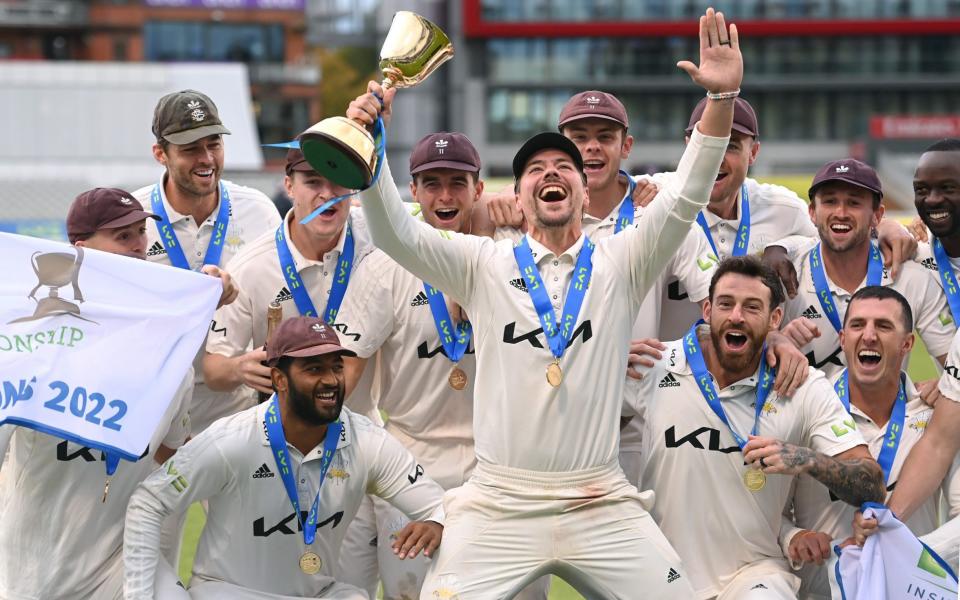How the counties fought back to win cricket's civil war

The high-performance review led by Sir Andrew Strauss was supposed to radically shake up the 132-year-old County Championship but it now looks like the Hundred will be the competition set for change after a fightback from the shires.
The counties have rejected out of hand recommendations to split the championship into a top division of six and cut the number of matches from 14 to 10; the idea being to slim down the competition and make it more competitive.
Strauss has recently written to all 18 counties asking to reopen the debate in an effort to salvage the plans but there is little hope of agreement until a review of the England and Wales Cricket Board’s finances, launched by new chair Richard Thompson, is completed next year.
County chairs are demanding to know the full costs of the Hundred and the financial implications of any change to the domestic structure, with many worrying that a reduction in cricket is an “existential threat” to their existence. There has also been a rebellion of county members that stiffened the resolve of clubs against change.
There is now a strong possibility, Telegraph Sport understands, that the Hundred could lose its August school holiday window and be played a few weeks earlier in June-July, which would allow Test cricket and championship matches to once again be played in August from 2024 (the schedule for next year has been decided and circulated to counties with little change).

Telegraph Sport revealed last month the competition could also be cut from four weeks to three by playing more double headers. If the championship remains at 14 matches then it has to be played in August to allow players to recover and the Hundred will need to be squeezed.
A change in leadership at the ECB, with Thompson becoming chairman in September and Richard Gould joining as chief executive in the new year, has already seen a cultural shift away from the Hundred dominating the board’s outlook.
Rebalancing the game is one of the core aims of Thompson and Gould, who were ardent critics of the Hundred when they ran Surrey and warned of the implications it would have on the domestic game. Both are good communicators with supporters and accept the division caused by the Hundred is playing out now in the debate over the county structure.
It was believed the school holiday period was essential to attract family audiences. But unlike in Australia, where the Big Bash is played in the school holiday, insiders believe more families in England go overseas for their holidays and it is believed this is going to affect Hundred attendances as life returns to normality after the pandemic.
The Hundred has existed in a bubble at the ECB with its own budget and staff. It costs around £40m to run, including the payments to the counties, which equals roughly the budget for England men’s cricket.
Is the Hundred justifying its cost?
The questions being asked now is whether the Hundred is giving the returns necessary to justify the cost, not necessarily financially, but how it has complicated and compacted the schedule. Audience figures for the BBC fell by up to 20 percent this summer.
“We know the source of funds at the ECB until 2028 (the Sky deal is worth around £220m annually) but is the application across all cost centres we do not know,” said one county chairman. “How much is spent on the Hundred? How much is spent on ECB overheads and what is the Hundred contributing? Greater income should mean a greater distribution but that doesn’t seem to be happening with some clubs still on the breadline.”
The game is split. In one corner, are those that back the high performance review and believe that investing in the Hundred, and making money from white-ball cricket, while streamlining the championship, will protect the long term future of the first class game. “I know, let’s ignore the best minds in the game and let a bunch of crusty old chairs who have never played cricket come up with an alternative. It makes us a laughing stock,” said one insider.

Then there are those in the other corner, who believe cutting red-ball cricket will weaken it, and worry a reduction in cricket will see clubs go out of business.
Added to this is a determined group of county members who forced their clubs to hold EGMs at the end of the season and pledge to not support any reduction in the amount of red-ball cricket without the agreement of their membership.
There are only around 70,000 members across 18 clubs – the exact figure is a closely guarded secret – and even fewer who are members of the County Cricket Members Group which has galvanised behind this issue.
'It is not the tail wagging the dog but the fleas on the tail wagging the dog'
“I think there is a very good chance that what was recommended by Strauss would have gone through if there had not been pushback from members,” said Alan Higham of the CCMG, who has campaigned for members to have more say in the running of their clubs.
“It was a big wake up call for county supporters to stand up. It jolted the bigger counties. I just hope the ECB now realises that doing things in isolated management teams, and running everything from the centre, is sub-optimal. They could achieve far more by bringing people together.”
But this resistance has frustrated those involved in the review. “It is not the tail wagging the dog but the fleas on the tail wagging the dog,” said one exasperated source. “We now have complete inertia through spineless chairmen and a handful of members. Are the chairmen going to ask their members if Christmas is still on December 25?”
The game is changing quickly, and the bigger threat for counties is not the changes advocated by its governing body but developments around the world.
Strauss warned the current schedule damages high performances and it will lead players choosing between the treadmill of 14 championship matches or saving themselves for franchise leagues. Will Smeed became the first young player to throw his lot in exclusively with white-ball cricket recently. Others are expected to follow.
'Those defending the status quo are killing it'
A new T20 league starts in the UAE in January and is offering salaries of £300,000 tax free. South Africa launches its T20 league at the same time creating tension in the market and a fight for English talent. Major League Cricket announced last week it will start in the United States in June 2023, offering another payday for white-ball cricketers.
“Look, those defending the status quo do not realise they are killing it,” says a county insider, (many are reluctant to go on the record because of the sensitivity of the issue).
“We are going to have third-tier players playing county cricket. The top tier are centrally contracted and you write off ever seeing them. Now we will have a second tier of players who build their schedule around T20 leagues, the Blast and the Hundred and will make themselves unavailable for most red-ball games. People just do not understand this.”
Strauss recommended a 10-game championship split between a top tier of six and two conferences of six teams. His report also called for a reduction from 14 to 10 Blast matches but did not analyse the effect of the Hundred on the schedule.
The review argued England play too much cricket at county level leaving players little time to work on specific skills and for groundsman to prepare good quality pitches that mirror those in Test cricket.
Officials at the ECB involved in high performance are understood to be very frustrated by the reluctance of counties to embrace change but ultimately accept it is their right to decide the level of cricket they play.

Sean Jarvis, chief executive of Leicestershire, estimates the reduction in cricket would cost his club £275,000 in match-day income losses even before the wishes of members were taken into account.
“When we analysed the proposals and put it through our business model at Leicestershire it was apparent the financial impact on our club was quite severe so for us it did not make sense to back the proposals,” he said. “ It would jeopardise our existence.”
County coaches pushed back against a top division of six believing the fear of relegation would prevent them giving younger players a chance – which has always been put forward as an argument for conferences rather than divisions. Most also did not agree with the conclusion that 10 games is enough but conceded that to play 14 matches means the championship has to be held in August.
The fight over the Hundred is complex. It is the ECB’s competition to do with what they like but Sky has bankrolled it and it is part of the broadcast deal until 2028. Broadcasters are as keen to attract younger, more diverse audiences as the ECB. They see the Hundred as that opportunity.
By reducing the Hundred, the ECB would be the only governing body in cricket to prioritise red ball over its franchise competition, which will be welcomed by many but does it make long-term business sense? The competition will only attract the best players through external investment. What message does it send to potential buyers if the governing body does not believe fully in its own product? That external investment will also trickle down to the counties.
No common goal
If the Hundred cannot pay the big salaries then it will become increasingly harder to sign the best players. The game is also close to IPL owners contracting its best players for 12 months a year, seizing more control. The championship, with its roots in Victorian England, is battling very modern forces.
At the moment there is no common goal, and never will be with so many competing interests among the counties and within the ECB.
England’s success this year has dampened enthusiasm for change too but the goal is to create a system that works regardless of who is leading English cricket so it does not rely on a Michael Vaughan-Duncan Fletcher or Brendon McCullum-Ben Stokes combination to come along and change fortunes. Anyone who has been on an Ashes tour recognises the structure is not doing its job.
“The status quo achieves nothing. This is not about playing 14 games or 10 games. It is actually about whether these counties are still here in 10 years’ time,” says a senior figure in English cricket.
Both sides agree on that but are miles apart on how to achieve it.

 Yahoo Sport
Yahoo Sport 





































